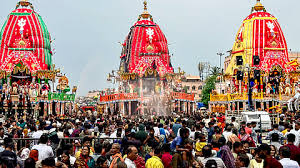‘No police, no systems in place… who will compensate my loss’: Lapses behind Puri’s Rath Yatra stampede

A day of devotion turned into a nightmare in Puri, Odisha, during the annual Rath Yatra. A sudden stampede broke out, injuring many and causing at least one death. The crowd, estimated in lakhs, quickly turned chaotic. Survivors now blame the absence of police and poor crowd control.
Many are asking: How could such a major festival, celebrated for centuries, lack basic safety systems?
‘There Was No One to Help Us’: Eyewitnesses Speak
Several survivors shared painful accounts. “There were no police, no medical teams, nothing,” said a woman whose father collapsed during the rush. He remains in critical care. Another devotee, visiting from West Bengal, described the experience as a “death trap.”
He recalled seeing people fall and others run over them. No barriers guided the crowd, and no officials were around to calm the panic. The lack of communication and help turned a sacred event into a scene of fear.
The Rath Yatra’s Significance and Scale
The Puri Rath Yatra is among India’s largest religious festivals. Lakhs of devotees gather to see Lord Jagannath and his siblings Balabhadra and Subhadra on massive wooden chariots. The deities travel from the Jagannath Temple to the Gundicha Temple.
This year, the turnout crossed 10 lakh. With crowds this large, safety planning becomes critical. Barricades, trained police, medical posts, and traffic control are basic needs. Yet, many say these were missing or poorly managed.
Where Was the Crowd Management Plan?
Civic volunteers and local observers pointed out several failures. CCTV cameras went offline. Exit routes were blocked by vendor stalls. People couldn’t move freely.
Mobile networks also failed. Many couldn’t contact their families or emergency services. Authorities blamed “unexpected crowds,” but critics say such numbers were predictable.
A few volunteers tried to direct the crowd, but without police or proper tools, they were helpless. The panic worsened as people couldn’t find escape routes.
State Government Under Fire
The Odisha government is facing harsh criticism. Opposition parties, including the BJP and Congress, demanded a high-level inquiry. The National Human Rights Commission may also seek a detailed report.
Top officials, including the Chief Secretary and DGP, promised investigations. But locals want action, not just statements. “We hear this every year. What changes? People still die,” said a social worker in Puri.
Families Demand Justice and Compensation
Relatives of the injured and deceased are angry. They want answers and proper compensation. The government announced ₹5 lakh for the family of the person who died and free treatment for the injured.
But for many, money is not enough. “My brother didn’t die in an accident. He died because no one did their job,” said a man who traveled from Cuttack for the yatra.
Others echoed the same frustration. “We came with faith. We left with fear.”
Is This a Pattern Across India?
Stampedes during religious events are sadly common in India. The Kumbh Mela, Vaishno Devi, and Sabarimala have all witnessed deadly incidents. In 2008, over 140 people died at the Naina Devi temple in Himachal Pradesh.
Experts argue these events reveal a nationwide issue. Religious gatherings need modern crowd control, not just tradition-based planning. Puri is no exception.
Technology and Training: The Need of the Hour
Experts suggest using tech tools like crowd-mapping apps, drone surveillance, and digital signboards. These can help track movement and predict danger zones.
Police need training in crowd psychology and response strategies. Events with over 5 lakh people should have real-time coordination centers. Volunteers and NGOs should be included in both planning and execution.
Currently, most safety plans are reactive, not proactive. That mindset needs to change.
Faith and Safety Must Go Hand in Hand
The Puri Rath Yatra stampede shocked the nation. But the greater tragedy would be if no lessons are learned. Religious devotion brings people together in hope and peace. It should never end in grief.
If India wants to protect its cultural heritage, it must protect its people first. The government must treat crowd management as a public safety issue, not just a festival detail.
Lakhs of devotees will return for the Bahuda Yatra, the return journey of the deities. Authorities have one last chance this year to correct their mistakes. If they fail again, public trust may not return as easily as the chariots.






